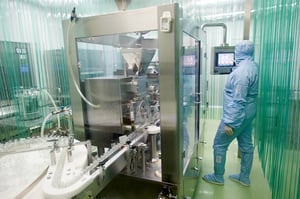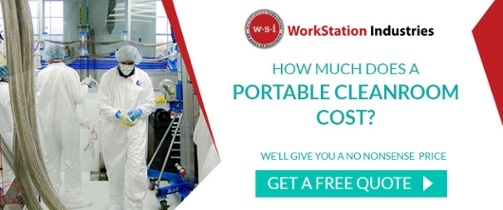If your application uses a clean room, you may need some level of additional protection in the form of garments.
However, with the proper type of clean room in place that meets the needs of your application, you may not need to rely on garments as much to protect against contamination.
What are clean room garments? Clean room garments are protective clothing one wears upon entering and when inside a clean room. They are an essential piece of safety equipment in many laboratories and serve two purposes:
- To protect the wearer from exposure to dangerous materials inside the clean room
- To protect the clean room from contaminants brought in by the wearer
If you have a modular clean room or are considering installing one for your laboratory, you are likely concerned whether you are putting the necessary structures in place to control contamination levels.
Below we’ll explore:
- What a clean room is
- How the cleanliness level of the clean room you install can impact what garments your lab requires
- What types of garments are available
What Is A Clean Room?
 A clean room is a controlled environment often found in environments where a higher standard of cleanliness is required, such as in manufacturing, pharmaceutical and laboratory environments. By controlling the level of contamination inside, the clean room helps keep applications free from pollutants such as aerosol particles, vapors, dust and airborne microbes.
A clean room is a controlled environment often found in environments where a higher standard of cleanliness is required, such as in manufacturing, pharmaceutical and laboratory environments. By controlling the level of contamination inside, the clean room helps keep applications free from pollutants such as aerosol particles, vapors, dust and airborne microbes.
There are two types of clean rooms...Hardwall and Softwall.
Hardwall clean rooms are permanent structures that are built into a building. They require far more construction considerations than a modular space. Because of this, they are far more expensive.
For example, hardwall clean rooms often require multiple contractors, construction permits, the addition of walls and ceilings using raw materials and a new duct system put into place. Plumbing and electric components must also be designed and installed.
All of these components lead to a price tag of $1,500 per square foot on average.
Softwall clean rooms, also known as portable or prefab clean rooms, can be assembled in days or weeks because all of the components of the clean room have already been manufactured. Construction consists of simply assembling the parts together.
They also offer the extra advantage of flexibility, since softwall clean rooms can be relocated or enlarged should your needs change. The price of a softwall clean room is significantly less expensive than that of a traditional room at only $100 to $150 per square foot on average.
If your lab requires a clean room, does it also require an extra layer of protection in garments?
It Depends On Your ISO Classification
The lower your ISO classification number, the more clean room garments that likely will be required.
What is ISO classification? In the United States and Canada, the primary authority of clean room classifications is the International Standards Organization (ISO) classification system, ISO 14644-1. These classifications address the level of cleanliness in the air, according to the particle size and concentration found in the air.
ISO 1 rooms are considered the cleanest, whereas ISO 9 are the least clean (though still much cleaner than a regular space).
Typically, applications that have the highest ISO classifications such as ISO 1 will involve very specialized operations, such as some life sciences applications or medical device manufacturing. In these situations, many manufacturers already have permanent, onsite clean rooms as part of their everyday operations.
If you’re looking into installing a portable clean room, your ISO requirements may not be as stringent. While softwall rooms can still provide extremely high levels of cleanliness, if your application requires a lower ISO level, you may need very few garments or none at all.
Remember, the industrial furniture you place inside your clean room can also help you maintain your ISO classification to ensure your project is not compromised. Countertops, fume hoods, workstations and even chairs can impact a room’s cleanliness levels.
You may even only need a laminar flow workbench to maintain the required levels of cleanliness for your project. A laminar flow workbench is designed as a low-cost alternative to a clean room. It provides a way for businesses to protect their work from contamination because it is designed with a specialized hood on it.
Air is drawn through a HEPA (High Efficiency Particulate Air) filter in the hood and blown away from the parts or materials on the bench in an unidirectional manner, either vertically or horizontally across the worksurface. There are different classes of filters available, depending on the level of cleanliness needed.
You can read more about common uses of laminar flow workbenches in our article, When Should You Use A Laminar Flow Workbench?
Bottom line: Which specific clean room garments are required depend on your ISO classification, as well as other factors specific to your application.
Types Of Clean Room Garments
 If you determine clean room garments are required for your project, the next question is, “Which ones?”
If you determine clean room garments are required for your project, the next question is, “Which ones?”
Clean room garments are generally lint-free and non-shedding. They are constructed using materials such as polyester or polypropylene. Polyester is often used to create static dissipative fabric, which can be ideal for controlled environments where electrostatic discharge (ESD) is a concern. Polypropylene allows moisture to evaporate more quickly than traditional clothing. It is also resistant to many acids and alkalis.
Depending on the type of garments your workers wear, their garments may have a single layer of polypropylene or several layers of polypropylene for greater durability.
There are a wide variety of garments that cover everything from head to toe. Types of clean room garments include:
- Face masks
- Boot covers or shoe covers
- Coveralls
- Gloves
- Goggles
- Beard and hair covers
- Bouffant caps and hoods
- Lab coats
- Intersuits worn under coveralls
Garments can also be disposable or reusable. Important considerations to keep in mind when determining whether your lab should purchase disposable garments or reusable garments include cost, if you have a method for regular disposal of these garments, and if your application has any laundering or sterilization requirements.
If your application requires the cleanest classification (ISO 1), it may be more cost-efficient to use disposable garments since you will likely need to use more complex laundering methods that ensure the safe cleaning and transport of garments without introducing contaminants.
An Overview
Every application and every industry may require a different set of cleanliness requirements and therefore different garment requirements.
In general, industries that would use pharmaceutical or medical device manufacturing are going to require a higher class of cleanliness classification. Therefore, garments like facial covers and gloves may be required. These garments may need to be changed upon each time a worker enters the space as well.
Industrial manufacturing clean rooms may not require the same level of cleanliness, so facial covers and gloves may be optional. Lower level classifications may not even require garments, and instead, cleanliness levels can be maintained through the use of a softwall clean room and appropriate industrial furniture inside.
It is important to note as well that because the protection that garments provide can vary based on the material used, it is important to check with a garment manufacturer before choosing which garments you need for your lab to ensure they meet your ISO classification requirements.


